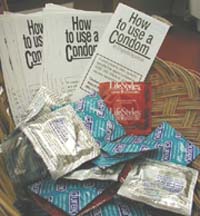Heterosexual Contact Passes Drug
Use as Main Cause of New HIV Cases

|
| The University of Maryland's health center offers free condoms to students as a way to curb the spread of HIV and other STDs.
(Newsline photo by Melanie Lo) |
By I-Wei J. Chang
Capital News Service
Friday, Jan. 28, 2005
WASHINGTON - Heterosexual transmission has moved past injected drug use as the
main cause of new HIV cases in Maryland, said the state's AIDS Administration.
The trend began in 2002 and continued into 2003, the latest year for which
figures are available. The administration said that 46.3 percent of people who
contracted HIV in 2003 reported doing so as a result of heterosexual contact,
while intravenous drug use made up 33.2 percent of the cases, and men who
reported having sex with men accounted for 17.5 percent.
In 2001, by contrast, injected drug use was blamed for 41.4 percent of new
HIV diagnoses, followed by heterosexual intercourse at 39.8 percent.
Colin Flynn, the chief of epidemiology and health services research for the
Maryland AIDS Administration, said the shift to heterosexual transmission of the
virus in the state simply mirrors the "common mode in the world" for spread of
HIV.
"Generally, HIV has three overlapping epidemics -- gay men, drug use and the
general population," Flynn said.
But others said the shift might not be so clear-cut.
John Nugent, chief executive officer of Planned Parenthood of Maryland, said
that there may be an overlap between some groups. For example, he said, there
are people who "originally acquired HIV through needles who are now practicing
unsafe sex through heterosexual intercourse," and attributed the virus to sex
and not drugs.
Flynn agreed that heterosexual contact and injected drug use seem to be
related. But, he said, "Given the large amount of heterosexual transmission, we
are also seeing heterosexual-to-heterosexual transmission."
Jeffrey Grabelle, program administrator of AIDS Action Baltimore Inc., said
drug use and heterosexual activity are hard to isolate, particularly in
Baltimore, where HIV/AIDS mainly result from a combination of heterosexual
activity and injecting drugs.
"Possibly a lot of them are lying," Grabelle said, referring to men who test
HIV-positive and cite heterosexual transmission as the cause. "Guys don't want
to admit to having sex with other guys and shooting drugs in the past."
One reason for the rise in heterosexual transmission could be "because we've
spent a lot of time in the homosexual and drug-using communities, and not so
much with heterosexuals," Nugent said.
Krupa Shinde of the Health Education Resource Organization (HERO) said the
shift underlines the need to broaden HIV-education efforts from specific groups
to the larger population
"HIV prevention is for everyone," said Shinde, program director of
prevention/education at HERO. "The highly vulnerable subgroups should be an
emphasis, but we shouldn't neglect the general community."
Copyright ©
2005 University
of Maryland Philip Merrill College of Journalism